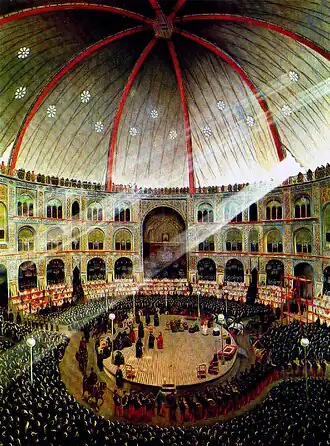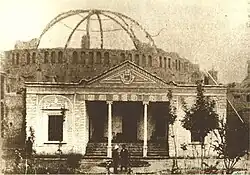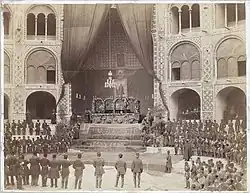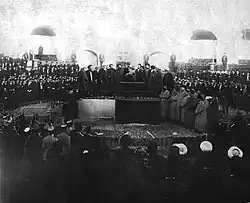Takyeh Dowlat
 Takyeh Dowlat by Kamal-ol-Molk | |
| Location | Tehran, Iran |
|---|---|
| Coordinates | 35°40′42.65″N 51°25′15.93″E / 35.6785139°N 51.4210917°E |
| Owner | Royal court of Iran (Qajar dynasty) |
| Genre(s) | Takyeh Theatre First Constituent assembly of Iran |
| Construction | |
| Opened | 1868 |
| Demolished | 1946 |
| Architect | Hossein-Ali Mehrin |
The Takyeh Dowlat (Persian: تکیه دولت, lit. 'State Takyeh'[1]) was a royal theater in Tehran, Iran. It was the most famous of all the ta'zieh performance spaces, for the Mourning of Muharram. It had a capacity for more than 4,000 people. Built in 1868[2] by the order of Naser al-Din Shah Qajar, south-east of the Golestan Palace on the site of the Síyáh-Chál, the royal theater's sumptuous magnificence surpassed that of Europe's greatest opera houses in the opinion of many Western visitors.[3] Samuel Greene Wheeler Benjamin said on his first visit that it was comparable to Verona Arena.
According to Karim Pirnia, Hossein-Ali Mehrin was the architect of this building.[4]
Notable events
It was here that Reza Shah proclaimed the downfall of the Qajar dynasty.[5] The Takyeh Dowlat was destroyed in 1947 and a bank building was constructed on its site.[6]
Gallery
-
-
 The Takyeh Dowlat adjacent to Emarat-e Bādgīr (the Windcatcher Mansion) in Golestan Palace
The Takyeh Dowlat adjacent to Emarat-e Bādgīr (the Windcatcher Mansion) in Golestan Palace -
 Main Entrance
Main Entrance -
 Naser al-Din Shah Qajar's funeral at the Takyeh Dowlat
Naser al-Din Shah Qajar's funeral at the Takyeh Dowlat -
 Reza Shah taking an oath at the Constituent assembly
Reza Shah taking an oath at the Constituent assembly -
 Spectators at the Takyeh Dowlat
Spectators at the Takyeh Dowlat -

References
- ^ Rayḥānah Shahristānī (1987). Iran in days of old. p. 164.
the State Takyeh
- ^ Abbas Amanat. Pivot of the universe: Nasir al-Din Shah Qajar and the Iranian Monarchy, p. 435.
- ^ "TA'ZIA". Encyclopedia of Iranica. Retrieved 2010-06-15.
- ^ Mohammad Karim Pirnia, Sabk Shenasi Mi'mari Irani (Study of styles in Iranian architecture), M. Karim Pirnia. 2005. ISBN 964-96113-2-0 pp.134-135
- ^ Saeed Alizadeh, Alireza Pahlavani, Ali Sadrnia. Iran: a chronological history . p. 197.
- ^ The world encyclopedia of contemporary theatre, Volume 3 edited by Don Rubin, p. 215.
35°40′42.65″N 51°25′15.93″E / 35.6785139°N 51.4210917°E